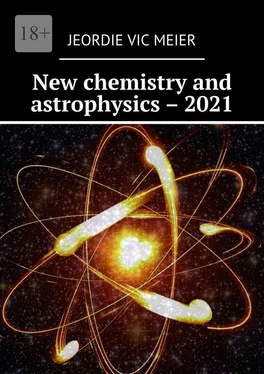Also need to remove the valence and numbers of electrons from chemical equations and tasks.
How can we talk about the valence of atom if not all substances in the periodic table consist of full-fledged homogeneous atoms, plus scientists do not know exactly how many electrons there are.
Now I understand why at school I didn’t want to solve these equations and didn’t even want to look at them.
Theoretical chemistry with equations and tasks where you need to arrange valences and electrons, this is all wrong, because elements in periodic table of Mendeleev are either defective damaged atoms or chaos from quarks and stardust, scientists do not know which ones of chemical elements are pure and how many electrons they actually have. They cannot describe what actually happens with chemicals when they are mixed. Need to create new education system in order to describe in detail processes that occur with chemicals in every chemical reaction.
Scientists are busy creating new atoms in laboratory, but they have not even studied the usual chemical elements, they do not know exactly how many electrons and hadrons are there, scientists are not even learned to isolate pure substance consisting of homogeneous atoms.
Great attention must be paid to safety of scientists, because many chemicals in their pure form are hazardous to health.
So chemistry will partly remain theoretical science, but I think people don’t really need pure substances consist of homogene atoms, we already have everything materials need for life.
Whole section of chemistry on chemical compounds is devoted to the theory that atoms attract to each other with help of electrons and thus form chemical bonds, in fact, full-fledged atoms at first will fight, they are irritated by presence of each other, they interfere with each other, because they can destroy each other, which happens over time, the heavier atom takes energy from other atom and this other atom is destroyed, loses electrons, and stronger atom, thanks to it, prolongs its life.
Atoms attract and hold each other not by electrons, but by the attraction of their energy centers. Normal atom has bright energy center with stable radiation.
Method of studying chemicals. Take a pea-sized plate of chemical substance and with the help of some kind of detector device (I think there are such devices in centers where the atom is studied) determine how much piece luminous points there (these are the energy centers of atoms) so scientists will understand how many atoms in different chemicals. Presence of glowing energy center means that there is an atom.
This atom has its own radiation.
*It seems to me that such topic as transformation of one chemical element into another more valuable one with other chemical properties has great potential. ..for example, we take meta, we need to change its energy charge by adding some chemical in this metal (carbon?), and then metal under photon emitter or under electricity for a different amount of time and check what will happen in 10 hours, in 20, 30 or 80 hours, a week, then metal will be saturated with energy and with the help of quark rubbish that is in almost any piece of material, the metal will become another more valuable chemical element by attaching new electrons. We can add quark rubbish and stardust from other substances so that metal can take hadrons from there for its transformation.
I cannot yet accurately predict the result of these experiments, but in any case, people can convert not very valuable chemical elements of which they have a lot into more valuable materials.
*Here is false theory of chemists. «Electrons pressed into core of atom and merge with protons there. From the fusion of electron with proton, a neutron is obtained? This is how neutron stars are formed.»
Еlectron is not quark so that neutron could’t be obtained from its merger with proton.
We know that neutron does not have electron, neutron is like an anchor for atom. Neutron is a set of quarks, it contains quark that is not present in proton, a heavier quark.
What is a full-fledged atom, it is a complete formed atom in which there are enough quarks, it does not have excess energy to which additional neutrons can join, all its energy is used, it is an energy system. There are atoms that lack quarks and they at the stage of formation.
*Hadron collider.
It would be interesting for me to work there and understand the meaning of their experiments of, they themselves do not fully understand what they are doing with body of galaxy (microparticles is body of galaxy), I would help them understand it. Although I think that they all mutated there a long time ago due to micro particles that are formed in the course of their experiments and one employees dies there regularly.
2.New chemistry table.
Introduction, for describing the structure of chemicals, I will use such word as stardust. These are fragments of stars of varying degrees of energy charge of which chemicals are composed, in addition to quarks, of which hadrons are composed. This stardust is part of the cosmic and solar radiation falling on the earth, some of which scientists have already studied. But it is an indisputable fact that the matter around consists not only of hadrons, just the scientists – chemists have forgotten about it.
This stardust has different properties, it creates attraction around which the nucleus of the atom is formed, it creates gravity and the attraction of materials. Protons and neutrons of hydrogen can’t do that.
These particles can attract electrons, take and give up energy.
* Determination of protons and neutrons.
Only the lightest pieces of stardust are combined into hadrons. Take the example of hydrogen atom as an elementary hadron. And in order for these hadrons to unite to create a more complex atom, they need an energy-charged stellar particle that is heavier than ordinary quark, which will be located in the center of atom as center of energy attraction, it must be stronger than quark in order to be able to concentrate the energy of the nucleus in itself and keeping its integrity. The heavier the atom, the more stardust in its core.
Using the hydrogen atom as an example, we see that the maximum number of hadrons that can unite into the nucleus of an atom is 3 hadrons.
Scientists have discovered many particles that are part of cosmic radiation, of course, these particles are part of chemicals, which, according to scientists, consists only of protons and neutrons. I call these particles stardust, they differ in physical properties from the quarks that make up the proton and neutron of hydrogen.
Alpha, beta, gamma particles, various anti particles, bosons, photons. Plus particles of stardust are deformed on the earth as a result of energy exchange with each other, they can lose their energy charge and their properties change.
Scientists assume that alpha particles are helium nuclei, but wait, is helium dangerous to health? because alpha particles are dangerous, or is it some kind of special type of helium. Ordinary hadrons cannot harm the body, they are too light, particles of stardust, which are also part of the chemical substances, is harm to man.
These particles damage structure of the cell, they attract energy or other particles in the body, disrupting the functioning of organs.
Alpha particles are not helium nuclei, these are particles of stardust, perhaps it separated from the helium atom, because in addition to hadrons in helium there are particles of stardust, in all atoms except hydrogen they are, they are needed to attract hadrons particles to themselves and create a more complex atom. It’s needed so that hadrons can be attracted to each other and create something more complicated than hydrogen.
Betta particles, according to scientists, are electrons or positrons. What? Who believed that electrons can strong harm to the body, new electrons constantly enter us and we are alive.
Читать дальше












